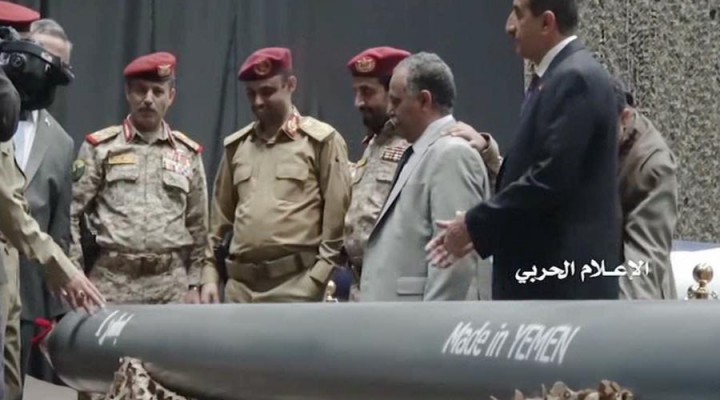How Yemen’s Houthis are bringing down a Goliath

“It is clear to us that Iran bears responsibility for this attack. There is no other plausible explanation. We support ongoing investigations to establish further details.”
The statement above was not written by Franz Kafka. In fact, it was written by a Kafka derivative: Brussels-based European bureaucracy. The Merkel-Macron-Johnson trio, representing Germany, France and the UK, seems to know what no “ongoing investigation” has unearthed: that Tehran was definitively responsible for the twin aerial strikes on Saudi oil installations.
“There is no other plausible explanation” translates as the occultation of Yemen. Yemen only features as the pounding ground of a vicious Saudi war, de facto supported by Washington and London and conducted with US and UK weapons, which has generated a horrendous humanitarian crisis.
So Iran is the culprit, no evidence provided, end of story, even if the “investigation continues.”
Hassan Ali Al-Emad, Yemeni scholar and the son of a prominent tribal leader with ascendance over ten clans, begs to differ. “From a military perspective, nobody ever took our forces in Yemen seriously. Perhaps they started understanding it when our missiles hit Aramco.”

Al-Emad said: “Yemeni people have been encircled by an embargo. Why are Yemeni airports still closed? Children are dying without treatment. In this current war, the first door [to be closed against enemies] was Damascus. The second door is Yemen.” Al-Emad considers that Hezbollah’s Secretary-General Sayed Nasrallah and the Houthis are involved in the same struggle.
Al-Emad was born in Sana’a in a Zaydi family influenced by Wahhabi practices. Yet when he was 20, in 1997, he converted to Ahlulbayat after comparative studies between Sunni, Zaydi and the Imamiyyah – the branch of Shi’ite Islam that believes in 12 imams. He abandoned Zaydi in what could be considered a Voltairean act: because the sect cannot withstand critical analysis.
I talked and broke bread – and hummus – with Al-Emad, in Beirut, during the New Horizon conference among scholars from Lebanon, Iran, Italy, Canada, Russia and Germany. Although he says he cannot get into detail about military secrets, he confirmed: “Past Yemeni governments had missiles, but after 9/11 Yemen was banned from buying weapons from Russia. But we still had 400 missiles in warehouses in South Yemen. We used 200 Scuds – the rest is still there [laughs].”
Al-Emad breaks down Houthi weaponry into three categories: the old missile stock; cannibalized missiles using different spare parts (“transformation made in Yemen”); and those with new technology that use reverse engineering. He stressed: “We accept help from everybody,” which suggests that not only Tehran and Hezbollah are pitching in.
Al-Emad’s key demand is actually humanitarian: “We request that Sana’a airport be reopened for help to the Yemeni people.” And he has a message for global public opinion that the EU-3 are obviously not aware of: “Saudi is collapsing and America is embracing it in its fall.”
The real danger
On the energy front, Persian Gulf energy traders that I have relied upon as trustworthy sources for two decades confirm that, contrary to Saudi Oil Minister Abdulazziz bin Salman’s spin, the damage from the Houthi attack on Abqaiq could last not only “months” but even years.
As a Dubai-based trader put it: “When an Iraqi pipeline was damaged in the mid-2000s the pumps were destroyed. It takes two years to replace a pump as the backlogs are long. The Saudis, to secure their pipelines, acquired spare pumps for this reason. But they did not dream that Abqaiq could be damaged. If you build a refinery it can take three to five years if not more. It could be done in a month if all the components and parts were available at once, as then it would be merely a task of assembling the components and parts.”
On top of this, the Saudis are now only offering heavier crudes to their customers in Asia. “Then,” adds a trader, “We heard that the Saudis were buying 20,000,000 barrels of heavier crudes from Iraq. Now, the Saudis were supposed to have as much as 160 million barrels a day of stored crude. So what does this mean? Either there was no stored crude or that crude had to go through Abqaiq in order to be sold.”
Al-Emad explicitly told me that Houthi attacks are not over, and further drone swarms are inevitable.
Now compare it with analysis by one trader: “If in the next wave of drone attacks 18 million barrels a day of Saudi crude are knocked out, it would represent a catastrophe of epic proportions. The US does not want the Houthi to believe that they have such power through such fourth generational warfare as drones that cannot be defended against. But they do. Here is where a tiny country can bring down not only a Goliath such as the US, but also the whole world.”
Asked about the consequences of a possible US attack against Iran – picking up on Robert Gates’ famous 2010 remark that “Saudis want to fight Iran to the last American” – the consensus among traders is that it would be another disaster.
“It would not be possible to bring Iranian crude on line for the world to replace the rest of what was destroyed,” said one.
He noted that Senator Lindsey Graham had “said he wanted to destroy the Iranian refineries but not the oil wells. This is a very important point. The horror of horrors would be an oil war where everyone is destroying each others’ wells until there was nothing left.”
While the “horror of horrors” hangs by a thread, the blind leading the blind stick to the script: Blame Iran and ignore Yemen.
https://www.asiatimes.com/2019/09/article/how-yemens-houthis-are-bringing-down-a-goliath/
 TheAltWorld
TheAltWorld 
0 thoughts on “How Yemen’s Houthis are bringing down a Goliath”